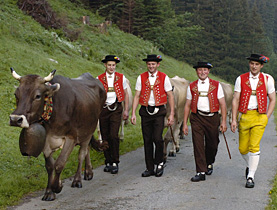Swiss celebrate an office which really counts

When Switzerland held its first national census in 1850, funds were so tight that the interior minister, helped by his secretary, had to evaluate the raw data himself.
By the time the next census came round in 1860, the minister, Stefano Franscini, was dead – some say of overwork – but statistics were being taken much more seriously. Parliament had passed a law setting up a statistics office, and had ordered a census to be held every ten years.
The Statistics Office, which is now celebrating its 150th anniversary, has come a long way since then. It started off with four employees and an annual budget of SFr20,000 – one quarter of which was the director’s salary.
It now employs 760 people, and has a budget of SFr160 million ($165 million), although as the current director, Jürg Marti, assured the guests at a commemorative event, “the director’s salary no longer accounts for a quarter of the sum”.
The Statistics Office has changed and developed over the years – and this continues. As Interior Minister Didier Burkhalter told the gathering, “there is no such thing as static statistics.”
New ways of thinking
Hans Wolfgang Brachinger, president of the Federal Statistics Commission, and director of the Center for Research in Economic Statistics at Fribourg University, gave a stark illustration of why statistics must continue to develop.
“More and more people see a growing gap between what they are interested in, and what national statistical offices measure,” he said. “If the public don’t trust official figures… this could even endanger their trust in democratic institutions.”
He gave swissinfo.ch an illustration of what he meant: when the euro was introduced, official statistics showed that resulting inflation was low, while ordinary people felt it was high. In Greece people were so angry that the police had to be summoned to protect the statistics office.
“They saw the office as an instrument of power of the ruling parties,” he said.
A complex phenomenon like inflation has different aspects, and these need to be measured in different ways for different purposes, he explained. He has developed an “index of perceived inflation”, to register the public’s subjective views.
The price index used in traditional inflation statistics gives a high weighting to expensive items, but ordinary people are interested in things they buy frequently.
“As a daily purchaser, what’s important for me is the price of bread and butter, not a flat screen or a BMW,” he said.
It’s not that one is right and the other wrong: the traditional consumer price indices are what National Banks and the European Central Bank need, the “index of perceived inflation” is what consumers want to know.
His centre has drawn up an index for Switzerland, which he expects to be published in the next few weeks.
“Of course, classical statisticians don’t like it. They want to go on doing what they’ve always done.”
“Until now, the traditional attitude of official statistics has been that they weren’t basically bothered about the public. Who commissions them? Governments, national banks – not the public.”
Calling the tune
In the early days of the Statistics Office, interest groups were already influential in deciding what statistics should be collected.
“Basically no-one denied that statistics were important, but they didn’t agree which areas were the most important,” Hans-Ulrich Jost, retired professor of modern history at Lausanne University, told swissinfo.ch.
For example, statistics were collected on agriculture, but not on industry.
“It was partly that the entrepreneurs themselves didn’t want statistics to be collected, because they were afraid that the figures would give foreigners an insight into what was going on in Swiss industry.”
While admitting that information about such things as production costs could indeed have been useful to competitors, he thinks the fears were exaggerated.
“It’s all part of Swiss secretiveness and discretion, as you have with the banks too,” he said.
And social statistics were more or less ignored.
“Even before the First World War a trades union official asked a commission if they couldn’t draw up some unemployment statistics, but the commission rejected the suggestion, saying unemployment figures would only put foolish thoughts into workers’ heads.”
Innumeracy
Whatever effect statistics might have had on workers in the early 20th century, they are now part and parcel of our everyday lives.
Newspapers are full of graphs and graphics – but as Brachinger points out, to understand them properly you need to know something about statistics, which most people have not learned.
It is not only in newspapers; political campaigns often use, or misuse, graphs to influence opinions.
“A person is only able to realise there is a trap, if they have sufficient statistical education,” he warned.
More than 100 years ago the American humorist Mark Twain spun it slightly differently, but the basic thought was already the same: “Facts are stubborn, but statistics are more pliable.”
Established in 1860, 12 years after the foundation of the modern Swiss federation.
Based in Neuchâtel since 1998.
Before 1848, Switzerland had been a loose confederation of cantons, some of which – including Zurich, Bern, Basel and Geneva – had collected their own statistics.
The newly centralised state soon realised that it needed statistics from all over the country.
But the collection of statistics remained unsystematic and non standardised for many decades.
The first edition of the Swiss Statistical Yearbook appeared in 1891, and has done so ever since.
The Statistics Office launched its website in 1996. It now gets about 40,000 clicks every day.
The two main languages of the site are German and French; some information is also available in Italian and English.
The Statistics Office produces statistics covering 21 topics.
For many years Swiss statistical methodology was not compatible with other industrialised countries.
It was only in 2007 that the Statistics Office had adapted its methods sufficiently to be able to produce joint statistics with the European Union.

In compliance with the JTI standards
More: SWI swissinfo.ch certified by the Journalism Trust Initiative













You can find an overview of ongoing debates with our journalists here . Please join us!
If you want to start a conversation about a topic raised in this article or want to report factual errors, email us at english@swissinfo.ch.